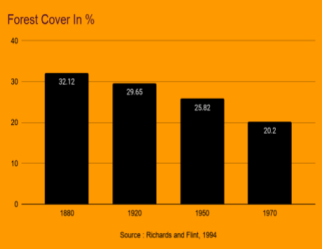Class 9 Social Science History Chapter 4 Summary Notes PDF Download
FAQs on Forest Society and Colonialism Class 9 Social Science History Chapter 4 CBSE Notes - 2025-26
1. How do these revision notes provide a quick summary of the key changes in Indian forestry during colonial rule?
These revision notes summarise the shift from traditional, local use of forests to a system of scientific forestry introduced by the British. They cover the implementation of the Forest Acts, the classification of forests into Reserved, Protected, and Village categories, and the primary colonial objective of exploiting timber for railways and shipbuilding.
2. What key concepts related to deforestation are explained in the Class 9 History Chapter 4 notes?
The notes explain that colonial deforestation was driven by several factors. A quick revision will cover the following key concepts:
- Expansion of railways: Forests were cleared to lay tracks and to provide wood for fuel and railway sleepers.
- Commercial crops: Large forest areas were given to planters for tea, coffee, and rubber plantations.
- Shipbuilding: The Royal Navy required a massive, continuous supply of strong timber like oak and teak for building ships.
3. How did the colonial concept of a 'proper' forest differ from the perspective of local villagers?
The colonial administration saw forests purely as a source of commercial timber. A 'proper' forest for them was one with neat rows of a single, valuable tree species. In contrast, villagers viewed forests as a source of diverse resources for their daily needs, including fuel, fodder, leaves, fruits, and herbs. This conflict in perspective is a central theme for revision.
4. What was the role of Dietrich Brandis, a key figure mentioned in these notes?
Dietrich Brandis, a German expert, was appointed as the first Inspector General of Forests in India. His key role, as summarised in these notes, was to introduce 'scientific forestry'. He established the Indian Forest Service in 1864 and helped formulate the Indian Forest Act of 1865, which formalised the state's control over forests.
5. How did the Forest Acts fundamentally change the daily lives of forest dwellers?
The Forest Acts made everyday activities of forest dwellers illegal. Their lives were severely impacted as they could no longer:
- Engage in shifting cultivation (jhum or swidden agriculture).
- Hunt animals for food.
- Graze their cattle freely.
- Collect firewood, fruits, or other essential forest produce without permission.
This disruption is a critical point to grasp for a complete revision of the chapter.
6. Why was shifting cultivation, or 'jhum', considered so harmful by the colonial foresters?
Colonial foresters considered shifting cultivation harmful for two main reasons. First, they believed the practice of burning vegetation would spread and destroy valuable timber trees. Second, it was very difficult for the government to calculate and collect taxes from land that was cultivated for only a few years and then left fallow. This made controlling the population and generating revenue challenging.
7. For a quick revision, how can one summarise the forest rebellion in Bastar?
The rebellion in the princely state of Bastar in 1910 was a direct response to colonial forest policies. Key summary points include the banning of shifting cultivation, hunting, and collection of forest produce, along with demands for free labour (begar). Led by figures like Gunda Dhur, the rebellion involved looting bazaars and burning the homes of officials and traders associated with the colonial state.
8. What is the main connection between the World Wars and forestry in India as covered in this chapter?
The World Wars led to a massive increase in the demand for timber for war-related needs. The British Indian government began cutting trees recklessly to meet these demands, abandoning the principles of scientific forestry. This period saw a significant escalation in deforestation, a key theme highlighted in the final sections of the chapter's notes.
9. How can these notes be used effectively for a last-minute revision before an exam?
For effective revision, focus on the flow of events presented in the notes. Start with the reasons for deforestation, move to the establishment of scientific forestry and the Forest Acts, understand the impact on local people, and finally, revise the major rebellions like Bastar and the Saminist movement in Java. Using the key terms in bold as revision cues is an excellent strategy.






































